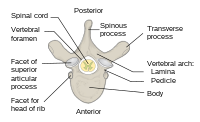
Photo from wikipedia
In this study, we used a previously developed osteometry-based method to calculate available range of motion in presacral intervertebral joints in artiodactyls. We have quantified all three directions of intervertebral… Click to show full abstract
In this study, we used a previously developed osteometry-based method to calculate available range of motion in presacral intervertebral joints in artiodactyls. We have quantified all three directions of intervertebral mobility: sagittal bending (SB), lateral bending (LB), and axial rotation (AR). This research covers 10 extant families of artiodactyls from 33 genera and 39 species. The cervical region in artiodactyls is the most mobile region of the presacral vertebral column in SB and LB. Mobility is unevenly distributed throughout the joints of the neck. The posterior neck joints (C4-C7) are significantly more mobile (on average by 2.5-3.5°) to anterior joints (C2-C4) and to the neck-thorax joint (C7-T1) in SB and LB. An increase in the relative length of the cervical region in artiodactyls is accompanied by an increase in the bending amplitudes (SB: Pearson r = 0.781; LB: r = 0.884). Animals with the most mobile necks (representative of Giraffidae and Camelidae) are 2-3 times more mobile in SB and LB compared to species with the least mobile necks. The thoracic region in artiodactyls, as in other mammals, is characterized by the greatest amplitudes of AR due to the tangential orientation of the zygapophyseal articular facets. The lowest AR values in the thoracic region are typical for the heaviest artiodactyls-Hippopotamidae. The highest AR values are typical for such agile runners as cervids, musk deer, pronghorn, as well as large and small antelopes. SB mobility in the posterior part of the thoracic region can be used by artiodactyls during galloping. The highest values of SB aROM in the posterior part of the thoracic region are typical for small animals with high SB mobility in the lumbar region. The lumbar region in mammals is adapted for efficient SB. Both the cumulative and average SB values in the lumbar region showed correspondence to the running type employed by an artiodactyl. The greatest SB amplitudes in the lumbar region are typical for small animals, which use saltatorial and saltatorial-cursorial running. An increase in body size also corresponds to a decrease in lumbar SB amplitudes. The lowest SB amplitudes are typical for species using the so-called mediportal running. Adaptation to endurance galloping in open landscapes is accompanied by a decrease in lumbar SB amplitudes in artiodactyls. The consistency of the approach used and the wide coverage of the studied species make it possible to significantly expand and generalize the knowledge of the biomechanics of the vertebral column in artiodactyls.
Journal Title: Journal of anatomy
Year Published: 2021
Link to full text (if available)
Share on Social Media: Sign Up to like & get
recommendations!